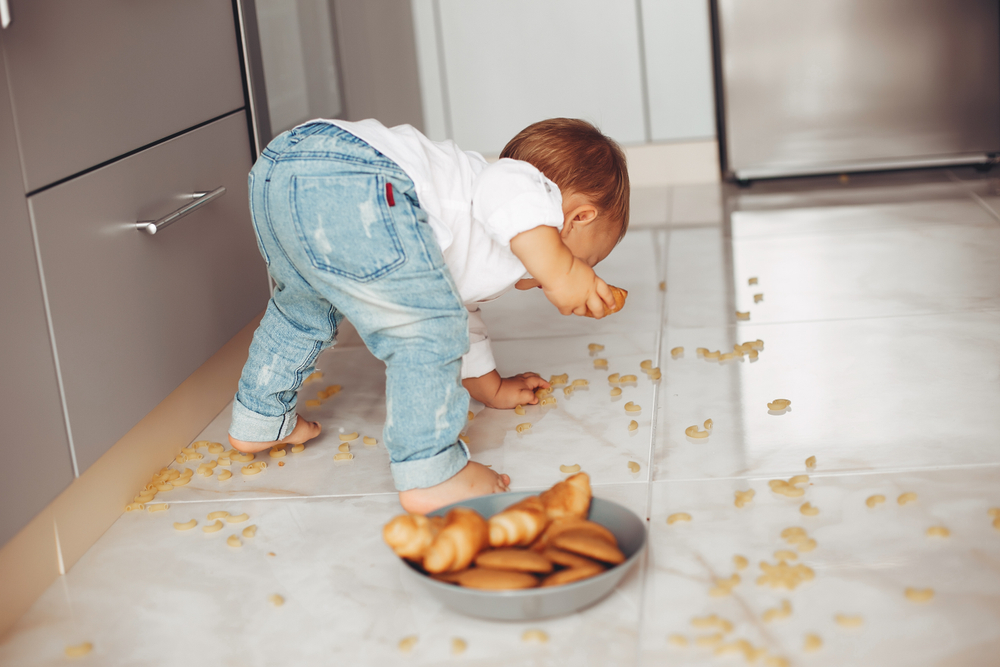You’re rushing around your kitchen trying to get dinner ready. You should have left the house 10-minutes ago. Somewhere between your toaster oven and countertop, the hot pocket you just heated up slides off the plate and lands smack dab on the floor! You’re not serving it to anyone else and no one is around to witness what you do next. So my question is: do you snatch it up quickly from the floor and eat it or do you throw your last ditch hope at dinner in the trash can?
Before you answer, I admit, I’d totally pick it up and eat it! But don’t you dare judge me until you hear what the scientific experts found when they studied the real life health effects of the 5-second rule on food that makes floor contact…
Almost 90-Percent of the Population Eats Fallen Foods!
If you’ve shamefully justified plucking food from the floor with the 5-second rule, you’re not alone. A survey, conducted by food scientists at Aston University’s School of Life and Health Sciences, put the urban legend to the test and found that roughly 87-percent of individuals admit to eating food that fell on the floor.
No Ladies, It’s Not a Guy Thing
Before the ladies in the house glare in judgment at their male spouses, siblings, fathers, and friends, be advised that 55-percent of the study participants who admitted to adopting the 5-second rule were, in fact, female.
Common Floor-Lingering Bacteria
According to the study findings, the common floor-lingering bacteria, identified by final year biology students, were:
- Staphylococcus aureus
- Escherichia coli (or E. coli)

Retrieval Time Does Matter
Results also determined that E. coli and Staphylococcus aureus bacteria take between 3-seconds and 30-seconds to develop on food that has touched a common floor surface. Timing does matter when it comes to bacterial transfer from floor to food.
So really, urban myth or not, it’s safer to eat food that has only had contact with the floor for less than 5-seconds than it is to consume food that’s been on the floor for 30-seconds or longer—ewwwww!
Initial Impact Affects Dry Foods
It would seem that the danger doesn’t depend so much on how fast you retrieve the food from the fallen surface, but if the food is wet or dry. The study found that the bacteria on dry foods didn’t differ during the 5- to 30-second timeframe, but that the bacteria transfer onto dry foods depended largely on the initial impact.
Quick Retrieval is Key For Moist Foods
The bacteria transfer on moist foods, on the other hand, was far lower the faster foods were retrieved from the floor’s surface. Which means, fast retrieval, or “quick is best,” is key to reducing bacteria transfer with moist foods.
Bacteria-Prone Floor Surfaces
It might also surprise you to learn that the study determined floor surface also affected bacteria formation time on foods. In fact, after comparing the 3 most common flooring surfaces—laminate, tile, and carpet—results showed that the carpeted flooring posed the lowest risk of bacterial transfer to the food that landed on its surface compared to higher bacterial transfer on food landing on tile and laminate surfaces.
Surface vs. Overall Environment
However, just to light alleviate any fears of those who’ve rescued chicken breast from tiled or laminated flooring, bacterial transfer of E. coli and Staphylococcus aureus bacteria from indoor flooring surfaces to food dropped there is also incredibly slim—as long as the overall environment is kept clean.
The 5-Second Rule Does Apply
In the end, we now have scientific proof to support the “5 second rule” theory. So really, urban myth or not, it comes down to retrieval time (5 to 30-second), flooring type (laminate, tile, or carpet), and food type (dry vs. moist). Overall, it’s likely totally safe to eat dry foods that have only had contact with a carpeted floor for less than 5-seconds! The highest risk of bacteria transfer comes with moist foods dropped on laminate or tiled surfaces for more than 5-seconds in length.











